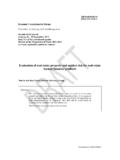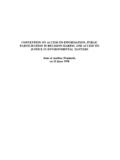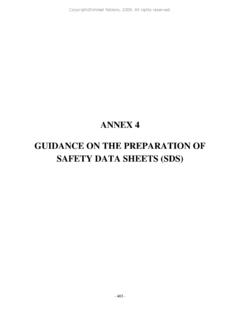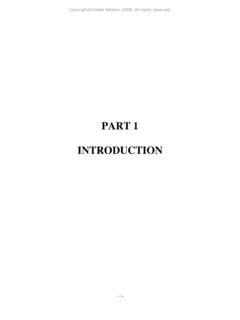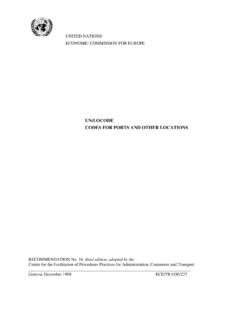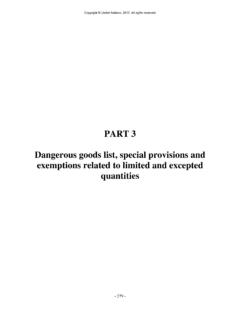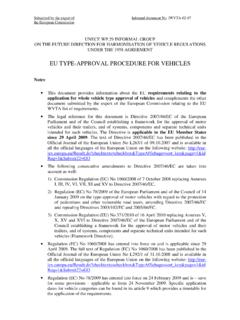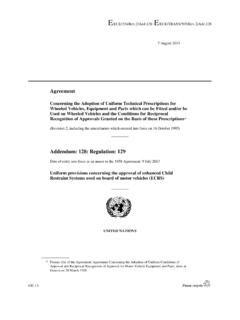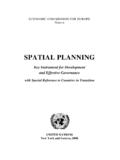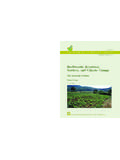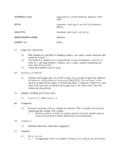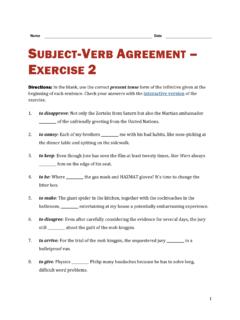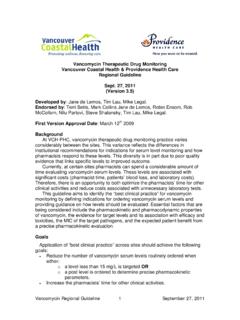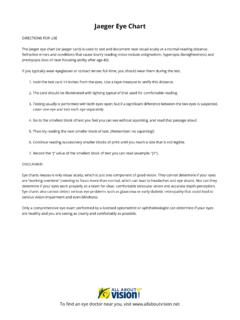Transcription of Forest Product Conversion Factors WP - UNECE
1 10 March 2009 Page 1 Forest Product Conversion Factors : PROJECT OVERVIEW AND STATUS 1. USE OF Conversion Factors Background The term Forest products Conversion Factors is used to cover a broad spectrum of ratios utilized in the Forest resource, manufacturing, and energy sectors. For the purpose of this paper, Conversion factor is defined as using a known figure to determine or estimate an unknown figure via a ratio. Often these ratios are absolute, for example converting cubic feet to cubic metres (always cubic feet in a cubic metre); and often ratios are not absolute, but rather a good average; for example, one m3 (under bark volume) of freshly felled Norway spruce sawlogs weighs 860 kg of which 80 kg is bark and 780 kg is wood.
2 In other instances, Conversion Factors may have little meaning unless one knows some of the parameters of what is being converted from and to. For example; one m3 of logs with an average small end diameter of 15 cm will make m3 of sawnwood that is dried and surfaced(<20% moisture content, and planed to a smooth finish); but, one m3 of logs with an average small-end diameter of 60 cm will make m3 of sawnwood (dried and surfaced). That is not to say that one cannot use a single factor to convert roundwood to sawnwood, this can be done with an accurate factor and when looking at a large population in the aggregate.
3 When looking at a lower level, however, Factors that account for various parameters or Factors that utilize the parameters via a regression formula are better suited. Often in combination with the use of Forest Product Conversion Factors is the use of the material balance . The sawnwood example above could leave one with the incorrect assumption that only 41% of the wood fibre in the 15 cm sawlog and 63% of the 60 cm sawlog were utilized. In fact, virtually 100% of the wood in both log groups were utilized. The remaining volume went to several wood residues having other and often distinct uses. For example: one m3 of 15 cm sawlogs could have a material balance of 41% sawnwood, 43% chips (raw material for paper), 9% sawdust (for making energy pellets, particleboard, MDF) and finally 7% shavings (for particle board, and energy fuel).
4 The components balance with 100%. Although not part of the material balance as the log volume was represented as under bark, one might also apply a Conversion factor to this scenario to estimate that 80 kg of bark is potentially available from each m3 of roundwood (measured under bark) for energy use (if the logs in question were Norway spruce). Trees and wood in particular have a predisposition toward the approximate as a result of the irregularity of shape and form, the variability of density and moisture content in wood fibre, and other natural variables that affect Conversion Factors such as species, size, age, defects, provenance, etc.
5 Wood fibre is also hygroscopic, thus its volume and weight in the green-roundwood state will be less once dried or exposed to the atmosphere. Compounding the aforementioned variables are the man-made biases and misrepresentation that also have to be accounted for, such as measurement inaccuracy, differences in measurement procedures which often reflect a unit volume differently than another standard does. Finally, there are differences that occur as a result of Product manufacturing efficiency levels and utilization practices, which vary significantly from one region to another. Conversion Factors general use: what do people use them for Conversion Factors have long been utilized by the Forest sector as an analysis tool for managing forests and Forest products manufacturing facilities.
6 In fact, many forestry handbooks have substantial sections on Conversion Factors , and there are quite a number of books available that are entirely dedicated to Forest products Conversion Factors . In science, there is only physics, all the rest is stamp Rutherford. 10 March 2009 Page 2 Virtually every aspect of forecasting and analysis in the Forest sector is somehow touched by Conversion Factors . Silvicultural growth models, biomass calculations, carbon sequestered in the Forest , timber sale appraisals, to name just a few, are all dependent on Conversion Factors . A practical level example of this would be a timber sale appraisal that a sawmill is conducting to determine a bid price per unit.
7 The stand volume may be reported in cubic metres outside bark but the purchaser may need to convert these volumes into inside bark volumes, weight or cubic foot to match their analysis units. To determine the value of the timber, the purchaser will need to know the cost of getting the timber from the stump to the mill site where weight to volume ratios are likely an important parameter for determining transport costs (m3 per truckload given a net weight capacity of 25 tonnes per truck). Primary Product recovery will need to be estimated using Conversion Factors from roundwood to the primary Product , , 2 m3 roundwood = 1 m3 sawnwood.
8 A material balance will be used to determine the quantity and thus value of the residual products made, and finally, ratios may be used to estimate the quantity of unmeasured products from the timber sale such as bark and logging residue (top-wood, limbs, foliage) which may be profitable to utilize for energy purposes. At a higher level, policy analysts and policymakers utilize Conversion Factors to determine the sequestered carbon in the forests of their country. The sawnwood trade agreement between the US and Canada was disputed in large part based on a quoted by FAO m3/mbf Conversion factor from the 1940s. Outlook studies on long-term wood availability and use are also highly dependent on the use of Conversion Factors .
9 Analysts have used Conversion Factors in an effort to try to indicate illegally logged roundwood in the supply chain of manufacturing facilities in a region, , when the roundwood removal volume is less than the apparent demand as determined via Conversion Factors ; it is assumed that the disparity may be made up of illegally logged volume. Additionally organizations such as CITES and others have been looking into the possibility of applying Conversion Factors to manufactured Product volumes as an indication of the harvest level of endangered species such as bigleaf mahogany1. Finally, roundwood to Product Conversion Factors are a good indication of efficiency levels and thus are often used to benchmark a manufacturing facility s effectiveness at converting raw materials into products.
10 Conversion factor use by UNECE /FAO: what do we use them for To paraphrase directly from the preface of Conversion Factors (Raw Material/ Product ) for Forest Products, 19872: Since its early days in the 1950s, the Joint FAO/ECE Working Party on Forest Economics and Statistics has been regularly dealing with Conversion factor problems. It was therefore considered necessary to monitor on a regular basis, changes in the raw material/ Product Conversion Factors . Information was collected for the years 1963, 1967, 1970, 1972, 1975, 1979, 1983, and 1987. A major objective of collecting and publishing this information on an international basis is to calculate national and international wood balances, notably in the context of the FAO/ECE studies of the FAO/ECE studies of European timber trends and prospects, in order to estimate wood requirements.
